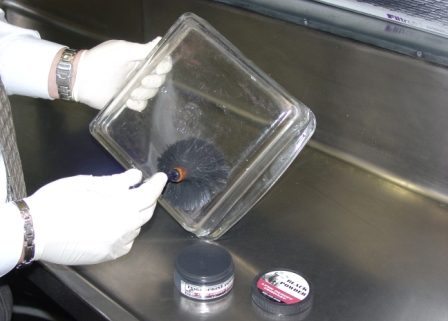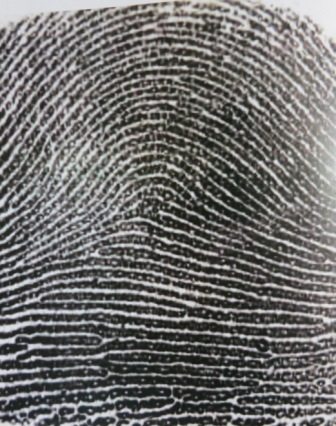Electrochemiluminescence: Fingerprinting With Electricity
Remember the good old days when dusting for prints meant using a brush to spread various colored powders across surfaces you thought and hoped a bad guy had touched? Then came time to apply the tape, when you prayed you wouldn’t screw up the fingerprint while removing the sticky stuff from doorknobs, desktops, knife blades, and the wall behind the toilet (yeah, sometimes guys place a hand or two there while tending to business).
Oh yeah, let’s not forget about the black powder that magically transferred to your clothing, your cheeks, your tie, to your partners hands, the walls, the dishes in the kitchen, the light switches, and the neighbors white cat. My goodness, that stuff is messy!
Well, there’s a bit of relief on the horizon for investigators who suffer from Mr. Monk Syndrome (don’t like to get their hands dirty). And that relief comes in the form of electricity. That’s right, there’s a new fingerprinting sheriff in town, and it’s called electrochemiluminescence.
Chinese scientists have devised a way to electrically “light up” fingerprints, even very old, or “barely there” prints. Electrochemiluminescence occurs when passing electrical current through the combination of a compound, such as ruthenium complex, and a partner chemical like tripropylamine. The mixture then becomes chemically unstable as electrons pass through (it’s in an “excited” state), causing it to give off light as it returns to ground (an electrical circuit flows from positive to ground/negative, sort of like completing a circle).
In this case, a technician transfers the print to a stainless steel plate (or glass plate treated with indium tin oxide), which serves as the electrode (the positive part of the circuit). A reagent solution containing the chemical compounds mentioned above is then added. Then, in short, the print simply lights up—ridge patterns, lines, outline of pores in the grooves, and even the finest of lines branching from the ends of the ridges are all illuminated.
These electrically-charged prints are so resolute that photographing a high quality image is easily achieved, and all without damaging the fingerprint.
So, maybe the day has finally come when there’ll be no more black smudges and stains all over the burglary victim’s white leather couch, white silk dress, freshly painted white walls, and white marble tiles.
Best of all, though, the investigator can go home at the end of the day still wearing a clean and crisp, bright white shirt.
And, no more black powder on the tip of the detective’s nose. Yep, as anyone who’s ever fingerprinted anything will tell you, as soon as the fingerprint powders come out, that’s when the nose starts itching like crazy.







Sandy – I received a response from the scientist(s) who discovered this process, and here’s the reply:
In the email you asked for the method used to transfer a fingerprint to the plate. Well, actually we didn’t transfer a fingerprint to the plate in that paper, the print was pressed on the plate directly. The author in the John Wiley article inaccurately described the process. However, we did do some research on transferring fingerprints from different substrates to the conducting electrodes, which are unpublished results. Detailed steps are not yet disclosed, the general process is as follows: a fingerprint was pressed on a commom substrate (such as a coin, desk, computer screen or disk), then it was lifted by a special tape, then the print on the tape was transferred to the conducting electrode, the tape was torn off and finally the electrode bearing a fingerprint was used for the imaging experiment. The resulting images are satisfying.
Lil. This technology is entirely different than what was used to capture your fingerprints. This fingerprinting method is used to electronically develop prints found at crime scenes.
What you saw in the sheriff’s office was a LiveSCan computer, or something similar. Here’s a link to one of my blog posts featuring a LiveScan terminal.
https://leelofland.com/wordpress/a-behind-the-scenes-look-at-processing-the-bad-guys/
I’m currently writing a scene where the protaganist is cleaning up after the fingerprint technician. Thank you for a timely post.
Sandy – I have a message out to the scientist who developed this process. I don’t want to say something that may not be correct.
How very cool!
Lee, how does the transfer of the fingerprint to the plate take place?
The last time I had my fingerprints taken (for my therapy license), it was by machine. Pain and ink free.:) This was in 2011 in a county sheriff’s substation, so its spreading every where.
I know, Becky. I’m glad this one wasn’t around back then!
I’m having flashbacks about trying to explain DNA to fourth-grade readers. At least it was easier to spell!
It’s brand new technology, Rusty, so I don’t have a clue when or if it’ll be approved for use by law enforcement in the U.S.
Is this currently being used? What agencies do you know of?
Interesting, Lee, especially after the fingerprint class at Sirchie.